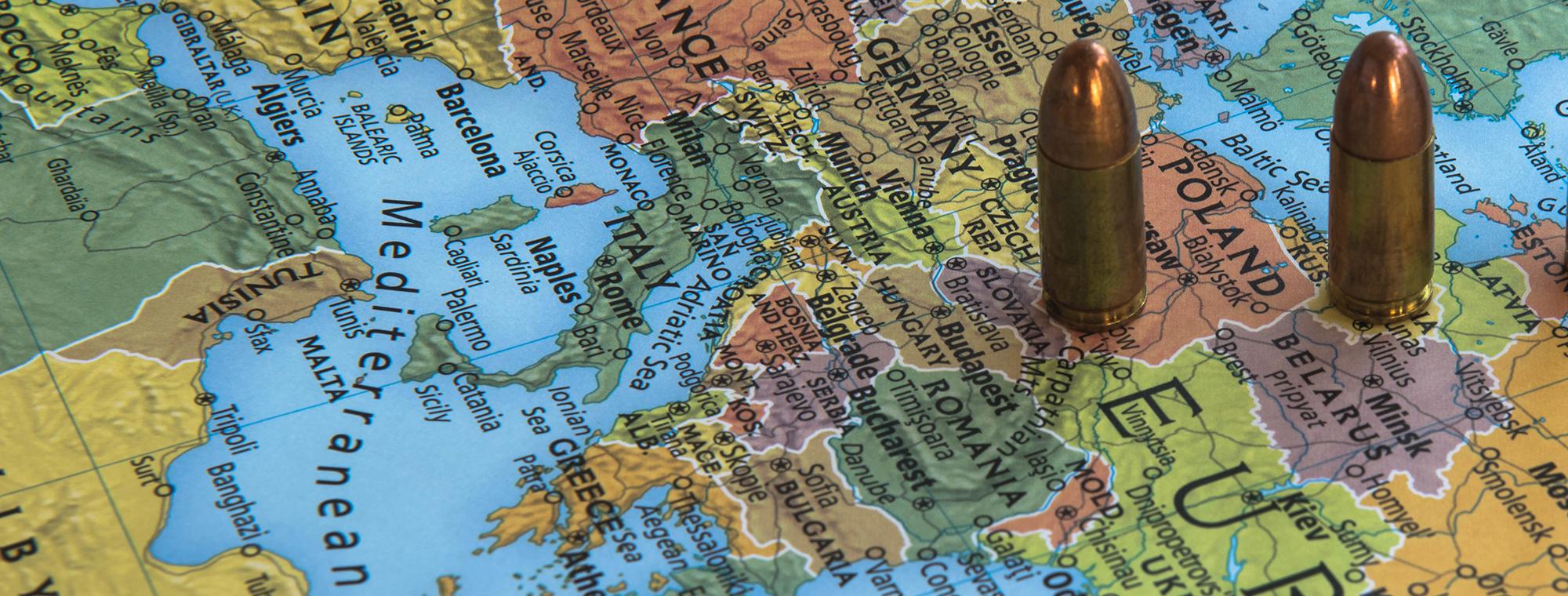Editor's Note: This essay is featured in our new report, "10 Big Nuclear Ideas for the Next President" (pdf).
The Iran nuclear accord, concluded in July 2015, has fundamentally improved the outlook for European security. Iran is now much less likely to obtain nuclear warheads, and its missile programs are proceeding more slowly than expected. As a result, current US plans to build additional interceptor missiles in Poland should be placed on hold.
The plan for missile defense in Europe was announced by the Obama administration in September 2009 to defend primarily against the developing nuclear and missile threat from Iran. Called the European Phased Adaptive Approach (EPAA), the word “adaptive” was used for a reason — the system would be deployed in phases, which could be adjusted to the threat as it developed. As President Barack Obama said in 2009, “if the threat from Iran’s nuclear and ballistic missile program is eliminated, the driving force for missile defense in Europe will be eliminated.”
EPAA’s first two phases are already in place to address Iran’s conventionally armed, medium-range missiles, but there is no need to extend that capability to target long-range missiles that Tehran does not possess. As the French ambassador to the United States, Gerard Araud, stated in May, “what we have done [on European missile defense] is enough… missile defense is not something we should do… just for itself… and it’s just common sense to link it to the re-evaluation of the threat.”
The next president should put deployment of EPAA’s third phase on hold while reassessing the plan. This pause would potentially save hundreds of millions of dollars and provide additional time to develop more capable interceptors, if needed. This pause would not preclude the possibility of deploying Phase III later. If Iran began developing longer-range missiles and resumed proliferationsensitive nuclear activities, there would be ample time to respond.
European Phased Adaptive Approach
The Obama administration came into office seeking a new relationship with Russia and a new approach to US plans to place anti-missile weapons in Europe. The Bush administration had called for large, land-based interceptors (similar to those in Alaska and California) to be stationed in Poland with radar in the Czech Republic. Their purpose was to defend US territory against intercontinental ballistic missiles (ICBMs) that Iran was believed to be developing.
In contrast to the Bush plan, President Obama’s EPAA is proceeding in phases with smaller sea- and landbased SM-3 interceptors developed for Aegis-equipped ships. The first two phases cover Southern Europe against missiles of short and mediumrange. However, later plans would come closer to those of the Bush administration. Phase III would deploy more capable interceptors in Poland to protect the rest of Europe from intermediate range missiles (IRBMs), and Phase IV would have targeted ICBMs aimed at the United States.
In line with EPAA’s purpose to avoid a capacity-driven approach disconnected from facts on the ground, in March 2013 the Obama administration cancelled Phase IV. As Deputy Assistant Secretary of State Frank A. Rose explained at the time, the interceptor planned for Phase IV had experienced “significant delays” due in part to insufficient congressional funding. A 2012 report by the Congressional Research Service noted that, “Iran has not demonstrated the kind of flight test program many view as necessary to produce an ICBM.”
| EPAA’s phases | |
|---|---|
| Phase I Complete. X-band radar placed in Kürecik, Turkey; Aegis-equipped ship with SM-3 Block IA interceptors deployed in the Mediterranean Sea in 2011; four US Aegis ships home-ported in Rota, Spain, in 2014-2015. | Phase II Complete. Aegis Ashore site, with Block IB interceptors and radar, built in Deveselu, Romania in 2013-2016; upgraded interceptors also deployed in ships. |
| Phase III Underway. Aegis Ashore site to be built in Redzikowo, Poland, with Block IIA interceptors in 2016-2018; upgraded interceptors also deployed in ships and in Romania. | Phase IV Cancelled. Would have deployed Block IIB interceptors in Poland by 2022. |
With Phase I and II already in place, Phase III commenced on May 13, 2016, with groundbreaking on a land-based Aegis Ashore site in Poland, set to be completed in 2018.
The Faulty Security Rationale for Phase III
Since 2013, when Phase IV was cancelled, the threat environment has undergone profound changes. In July 2015 Iran and world powers reached a historic nuclear accord, the Joint Comprehensive Plan of Action (JCPOA). By bringing about an intrusive inspections regime, as well as significantly reducing Iran’s stockpile of enriched uranium and operating centrifuges, the JCPOA, if fully implemented, ensures that the country will not produce fissile material for a nuclear warhead for the next 15 years. If Iran were to withdraw from the accord and embark on a crash nuclear weapons program, there would be at least two years for the international community to respond. The accord is also leading to a normalization of relations between Iran and European countries.
At the same time, Iran’s missile development has fallen short of previous predictions. Iran’s arsenal is still limited to short and medium-range missiles, and Tehran does not seem to be interested in extending their reach. As Michael Elleman at the International Institute for Strategic Studies points out,“during the past decade, Iran has focused on improving the accuracy and reliability of its missiles, with little attention to increasing range.” However, if Iran decided to develop an operational IRBM, this would require at least 3-5 years of testing.
There is thus no need, at this time, for more advanced interceptors against non-existent Iranian IRBMs. Although Iran’s medium-range missiles could reach some NATO countries in Southern Europe, the infrastructure that was put in place during EPAA Phases I-II already covers this geographical area.
Regarding Phase III, former State Department intelligence analyst Greg Thielmann has noted that “the higher speed Aegis missiles to be deployed in Poland are designed to intercept longer-range missiles than Iran has developed,” and that, “it is high time for another course adjustment in EPAA implementation.”
Despite the reduced threat from Iran, some seek to justify Phase III by pointing to missile threats from other countries. However, this is not necessary. The only Middle Eastern country possessing IRBMs is Israel, a US ally that hardly threatens Europe, and the rest do not have advanced missile programs. Finally, missile interceptor technology is under constant development and, if deployed prematurely, will likely be obsolete by the time it might be needed.
Implications for Arms Control
Given its theoretical potential to neutralize an adversary’s nuclear second-strike capability, missile defense technology has given rise to strategic concerns since the Cold War. After those concerns were eased by the 1972 Anti-Ballistic Missile Treaty, the issue re-emerged with the US withdrawal from the treaty in 2002, triggering suspicions in Russia and China.
Russia has been particularly concerned with US missile interceptors in Europe. EPAA temporarily alleviated but never completely removed that problem due to the US refusal to give binding guarantees that the system is not targeted against Russia. Pointing to the potential of missile defenses to undermine its nuclear deterrent, Russia claims to have developed a new class of strategic nuclear weapons to bypass interceptors. It has also threatened to refrain from any future arms control agreements, to target countries hosting missile defense components, and to place Iskander nuclear-capable missiles in Kaliningrad for that purpose — an action that was reportedly carried out in October 2016.
Such reactions seem exaggerated, as the planned system is clearly no match for Russia’s current nuclear arsenal. As critics point out, any midcourse missile defense system is also easily rendered ineffective by countermeasures, such as decoys, and the test record for intercepting ICBMs is poor. However, Russian concerns are not completely unfounded. The key factor here is uncertainty created by future technological progress and political decisions. As Glenn Diesen and Conor Keane point out, “NATO has not ruled out the reintroduction of Phase IV nor has the possibility of a Phase V, Phase VI or Phase VII been excluded.” * A 2011 report by the Federation of American Scientists also suggests that the interceptors deployed in Phase III could in principle “be used to create an integrated continental US missile defense system that could engage Russian ICBM warheads” if moved to the north-western Atlantic. As the report notes, “even the most cursory Russian… assessment… would consider the potential geographical reconfiguration of a mobile ship-based system.”
This situation has implications for any future arms control efforts: from the Russian perspective, the more efficient and integrated Western missile defenses become, the more likely they could threaten its deterrent — particularly if the number of nuclear weapons were significantly reduced.
Implications for Regional Security
After failed efforts to find common ground, NATO-Russia consultations on missile defense waned after 2010 and ended with the annexation of Crimea. Since then, it has become commonplace to dismiss Russian antimissile defense rhetoric as part of its general intransigence. At the same time, Russian provocations have strengthened the Alliance’s resolve to stick to their previous missile defense plans.
Missile defense has thus become tied to the conflict with Russia, which partly explains its disconnect with the developments in Iran. On the other hand, European support for missile defense has never been driven solely by the Iranian threat. Certainly the Eastern European countries hosting interceptors and radars value the system mainly because of the American military presence that it brings on their soil. As Liviu Horowitz of ETH Zurich writes, “missile defense deployments… represent an American trip wire, one that reassures elites in many countries that Washington is guarding their security.” Against this background, and given the lack of clarity about the system’s purpose, recent calls within the alliance to turn missile defense against Russia are not surprising,even though this is surely not what President Obama meant when he made EPAA “adaptable” seven years ago.
Missile defense is currently giving Europeans a false sense of security. The interceptors in Southern Europe provide protection against potential missile threats from the Middle East, but the deployment of Block IIA interceptors in Poland is unnecessary and counterproductive.
The next administration should press the pause button before proceeding with Phase III. At the same time, it should come up with a more sustainable way to address Poland’s anxiety about Russia.
While adding nothing by way of protecting Europe either from Iranian or Russian missiles, Phase III is increasing regional tensions. It is also undermining long-term prospects for arms control, which — however unlikely they may now seem — still remains the only realistic safeguard against the threat of nuclear weapons.
Tytti Erästö is the Roger L. Hale fellow here at Ploughshares Fund, a global security foundation. She has a PhD in International Relations from the University of Tampere, Finland.
Follow Tytti Erästö on Twitter: @TyttiE
* Diesen, Glenn & Conor Keane, “Constraining Missile Defence.” Defense & Security Analysis 32:2 2016, pg. 129-143.
Press Pause on Missile Defense in Europe via @TyttiE.




